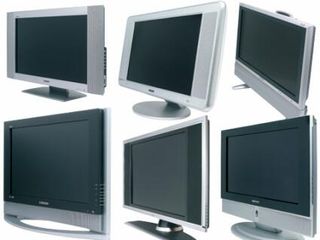26" LCD TVs: Are They Ready for Prime Time?
Separating The Wheat From The Chaff

As a follow-up to our article on flat-panel display technologies , we've prepared a comparative buyer's guide to LCD TV sets. Why LCD and not plasma? Because the manufacturers seem to have a clear preference for that technology, despite the undeniable quality advantages of plasma. LCD is less expensive to produce, less demanding technically, and perhaps most importantly, it is of greater appeal to the lower end of the market, where most of the buyers are. Unfortunately, LCD is also the technology that involves the highest risk for the purchaser: LCD specifications are often unrealistic, and quality can vary greatly from one model to another. There's a very real danger of paying more than $1,000 and getting a bad TV set.
Up until now, the TVs we've tested weren't very attractive, mainly due to their stiff prices. But that's changing rapidly, and the arrival of computer manufacturers on the market has something to do with the change, as you'll see shortly.
So, what do you need to know? What criteria do you need to go by in choosing a model? How do you match a model to your kind of viewing? We're going to try to answer those questions for you and more. This first article is essentially devoted to TV sets that measure 26" diagonally. A second review will cover sets with larger measurements.
What You Need To Know Before You Buy
What's The Right Size?
The TV sets we tested in this comparison all have a screen size of 26" or above. Why? Because below that size, the advantages of LCD technology are debatable. The main advantage of LCD is its ability to produce a large picture without increasing the thickness of the unit. Many people who choose a 20" LCD TV do so because of budget considerations, but in that area CRT TV sets are still unbeatable. An LCD TV smaller than 26" is not a good investment because the price/performance ratio is really not good enough. The choice will be purely a matter of esthetics, and that's not something that can really be debated.
Another determining issue is that an LCD TV smaller than 20" won't be usable for high definition TV (HDTV). The resolutions of these screens - 640x480 to 800x600 - are just not sufficient. 1280x768 is the minimum for HDTV, and models from 26" up all offer at least 1280x768.
So, the discussion begins at 26". Then, the choice of the panel will depend directly on technological and personal factors. For example, a 32" TV set offers a larger display area, but its interpolation performance is weak, which can be a problem in some cases as we'll see. You also have to take into account the cost of a 30" or 32" set, which is still above $2,000 in most cases. So for this first article, we've focused on 26" sets, because their prices are affordable and the technical problems are more under control. This represents the "sweet spot" of the LCD TV market right now, to a large extent.
Stay on the Cutting Edge
Join the experts who read Tom's Hardware for the inside track on enthusiast PC tech news — and have for over 25 years. We'll send breaking news and in-depth reviews of CPUs, GPUs, AI, maker hardware and more straight to your inbox.
Current page: Separating The Wheat From The Chaff
Next Page Brightness And ContrastMost Popular

